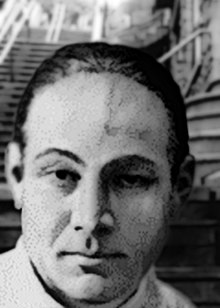|
Salvatore Maranzano
Salvatore Maranzano (Italian: [salvaˈtoːre maranˈtsaːno]; July 31, 1886 – September 10, 1931), nicknamed Little Caesar,[1] was an Italian-American mobster from the town of Castellammare del Golfo, Sicily, and an early Cosa Nostra boss who led what later would become the Bonanno crime family in New York City. He instigated the Castellammarese War in 1930 to seize control of the American Mafia, winning the war after the murder of rival faction head Joe Masseria in April 1931. He then briefly became the Mafia's capo di tutti capi ("boss of all bosses") and formed the Five Families in New York City but was murdered on September 10, 1931, on the orders of Charles "Lucky" Luciano, who established The Commission, in which families shared power to prevent future turf wars. Life and careerEarly yearsSalvatore Maranzano was the youngest of 12 children born to Domenico Maranzano and Antonina Pisciotta. Five of his siblings lived to adulthood: Mariano, Angelo, Nicolo, Giuseppe, and Angela. As a youngster, Maranzano had wanted to become a priest and even studied to become one, but later became associated with the Mafia in his homeland.[2] Maranzano had a very commanding presence and was greatly respected by his underworld peers. He had a fascination with Julius Caesar and the Roman Empire, and enjoyed talking to his less-educated American Mafia counterparts about these subjects.[3] Because of this, he was nicknamed "Little Caesar" by his underworld peers. Maranzano emigrated from Sicily to the United States in the 1920s, settling in Brooklyn.[4] The Sicilian mafioso Don Vito Ferro decided to make a bid for control of Mafia operations in the United States. From his base in Castellammare del Golfo, Maranzano was sent to seize control.[5] While building a legitimate business as a real estate broker, Maranzano also maintained a growing bootlegging business, using the real estate company as a front for his illegal operations. He soon became involved in prostitution and the illegal smuggling of narcotics; he also took a liking to a young Joseph Bonanno and became his mentor.[4] Castellammarese WarTo protect the criminal empire that Maranzano had built up, he declared war on his rival Joe Masseria, the boss of all bosses, in 1930, starting the Castellammarese War.[4] In early 1931, Lucky Luciano decided to eliminate his boss, Masseria. In a secret deal with Maranzano, Luciano agreed to engineer Masseria's death in return for receiving Masseria's rackets and becoming Maranzano's second-in-command.[4] On April 15, Luciano invited Masseria and two other associates to lunch in a Coney Island restaurant. After finishing their meal, the mobsters decided to play cards. At that point, according to mob legend, Luciano went to the bathroom. Four gunmen – Vito Genovese, Albert Anastasia, Joe Adonis and Benjamin "Bugsy" Siegel – then walked into the dining room and shot and killed Masseria.[6] With Maranzano's blessing, Luciano took over Masseria's gang and became Maranzano's lieutenant.[4] Boss of all bossesWith Masseria gone, Maranzano reorganized the Italian American gangs in New York City into the Five Families, headed by Luciano, Joe Profaci, Tommy Gagliano, Vincent Mangano, and himself.[4] Each family would have a boss, underboss, capos, soldiers, and associates. The families ("made men") would be composed of only full-blooded Italian American members, while associates could come from any background.[7][8][4] However, Maranzano called a meeting of crime bosses in Wappingers Falls, New York, and declared himself capo dei capi ("boss of all bosses").[4] Maranzano also whittled down the rival families' rackets in favor of his own. Luciano appeared to accept these changes, but was merely biding his time before removing Maranzano.[6] Although Maranzano was slightly more forward-thinking than Masseria, Luciano had come to believe that Maranzano was even greedier and more hidebound than Masseria had been.[4][9][6] Maranzano's scheming, his arrogant treatment of his subordinates and his fondness for comparing his organization to the Roman Empire (he attempted to model the organization after Caesar's military chain of command) did not sit well with Luciano and his ambitious friends, such as Vito Genovese, Frank Costello and others.[9] Despite his advocacy for modern methods of organization, including crews of soldiers doing the bulk of a family's illegal work under the supervision of a caporegime, at heart Maranzano was a "Mustache Pete" — an old-school mafioso too steeped in Old World ways. He was opposed to Luciano's partnership with Jewish gangsters such as Meyer Lansky and Benjamin "Bugsy" Siegel. Luciano and his colleagues had intended all along to bide their time before getting rid of Maranzano.[6] DeathBy September 1931, Maranzano realized Luciano was a threat, and hired Mad Dog Coll, an Irish gangster, to kill him. However, Tommy Lucchese alerted Luciano that he was marked for death.[10] On September 10, Maranzano ordered Luciano and Genovese to come to his office at the New York Central Building (now the Helmsley Building), at 230 Park Avenue in Manhattan. Convinced that Maranzano planned to murder them, Luciano decided to act first. He sent to Maranzano's office four Jewish gangsters whose faces were unknown to Maranzano's people. They had been secured with the aid of Lansky, Siegel and Gambino.[11] Disguised as government agents, two of the gangsters disarmed Maranzano's bodyguards. The other two, aided by Lucchese, who was there to point Maranzano out, stabbed the boss multiple times before shooting him.[12] This assassination was the first of what would later be called the "Night of the Sicilian Vespers".[12] Although there would have been few objections had Luciano declared himself capo di tutti capi, he abolished the title, believing the position created trouble among the families and would make himself a target for another ambitious challenger.[13] Luciano subsequently created The Commission to serve as the governing body for organized crime.[14] Maranzano is buried in Saint John Cemetery , Queens, New York, near Luciano's grave.[15] In popular culture
See alsoReferences
Further reading
|
||||||||||||||||||||||||
